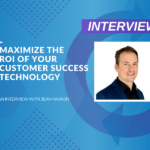Structure Your Organization Around Customer Value
As Customer Success experts, we get asked a lot of questions! When it comes to Customer Success Management, one question we get asked all the time is: how much revenue should each CSM be responsible for? Followed by: what is an optimal customer to Customer Success Manager (CSM) ratio? The answers to your capacity planning questions depend on your business and, more importantly, on your customer journey.
Recently, we outlined the process for robust customer journey mapping that puts your customer at the heart of your business and outlines all of their value driving touchpoints. This exercise is a critical precursor to properly structuring your organization and capacity planning. With your touchpoints and milestones mapped out, you can begin the planning process by determining the activities that you need to initiate to drive a positive customer journey and how to divvy up your resources and team to meet the needs of your customers. This capacity planning process will ensure that you end up with the most efficient distribution of resources and an optimal customer to CSM ratio.
In this article, we outline how to use your customer journey to create a streamlined organizational structure, how to effectively allocate your finite resources and how to fine-tune that operational model over time to create efficiencies and maximize customer value.
Determining Your Optimal Organizational Structure
Organizational structure is not one-size-fits-all; each company’s structure is going to be guided by and dependent on what success looks like for their customers. Best practice dictates that you begin with a comprehensive customer journey map, determine the activities that will support customer value delivery, and then decide how to allocate your resources to execute those activities. It’s these value-driving activities that will help you determine how to define the various roles and responsibilities within your organization.
For instance, if your product is intuitive and autonomous, you may want to designate more staff on the Support side who are primarily responsible for responding to questions, troubleshooting or dealing with reactive issues. On the other hand, if your product is very technical and nuanced, you may want to partner your business-minded Customer Success Manager (CSM) with a technical-minded Customer Architect for every customer. Ultimately, the objective is to understand your customers’ needs to determine if they require more or less of any given activity to ensure their positive experience and drive value and adjust your organizational model accordingly to meet those needs.
Determining Value-Driving Activities & Capacity Planning
Defining Value-Based Outcomes (VBOs) is also a crucial component of capacity planning. This exercise helps you ascertain how much time and energy each of those value driving activities should take, on average, and how many of those value driving activities, in what form, your team should be performing. For example, one of your objectives might be to hold regular business reviews to communicate value achievement to customers. In this situation, you surmise that your high-value customers are going to get more in-depth business reviews, more frequently. You also know that those business reviews are going to take two hours to deliver and eight hours to prepare, for a total 10-hour commitment per customer, per quarter. You then repeat this act for all the activities you want your CSMs to be driving, factoring in administrative work, to determine how many customers they can realistically take on and ultimately conclude what your ideal customer to CSM ratio is for that customer tier.
For effective capacity planning, begin by only outlining the various tasks that need to be completed to deliver value, without initially assigning responsibility. Ideally, you should map out all of these activities per customer segment. For example, decide the number of touchpoints per month, the number of success planning sessions per year and the amount of Executive Business Reviews (EBRs) per quarter for every high-value customer. Once you determine your ideal state per customer segment, you can work backwards to map out the length of a planning session and the amount of time spent on preparation, follow-up, and end-to-end maintenance. Repeat this process for every value-driving activity so that you can accurately allocate resources and determine each CSMs’ capacity. After this step, you can proceed to defining who is responsible for taking those actions, appointing the various roles and responsibilities and deciding how you’re going to track and measure those actions.
Fine-Tuning Your Operational Model
Your capacity plan is a living document. This plan is something you can, and should, continuously iterate upon and improve by auditing what your CSMs are spending energy and resources on. Instead of utilizing constant time tracking, which adds administrative overhead, we recommend a “core sample” method through regular time studies. Periodically, check where your CSMs are spending their time and if that tracks with what you expected. If you see that your team spends an inordinate amount of time doing non-customer-related activities or if they’re going over or under your estimated capacity plan on CS-related initiatives, find out why. Answering this question will help you improve your capacity plan, streamline your processes and create efficiencies in your organization. This iteration and improvement process relies on access to complete and accurate data, being truthful about what your customers care about and weeding out any activities that no longer add value to your customers.
Optimize Capacity Planning Using Data-Driven Insights
Identifying key value-driving activities is the first step to creating a streamlined organizational structure and ensuring an efficient distribution of your resources. By adhering to best practices, your resource and personnel allocation will be based on data-driven insights, rather than assumptions, to drive the maximum customer value at the right scale.
Driving market-leading recurring revenue rests on your ability to scale your value delivery pipeline. Read our article about how to effectively scale customer retention through Customer Success automation.






